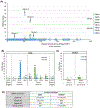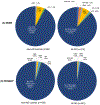Human Herpesvirus 6 Detection in Alzheimer's Disease Cases and Controls across Multiple Cohorts
- PMID: 31983538
- PMCID: PMC7182308
- DOI: 10.1016/j.neuron.2019.12.031
Human Herpesvirus 6 Detection in Alzheimer's Disease Cases and Controls across Multiple Cohorts
Abstract
The interplay between viral infection and Alzheimer's disease (AD) has long been an area of interest, but proving causality has been elusive. Several recent studies have renewed the debate concerning the role of herpesviruses, and human herpesvirus 6 (HHV-6) in particular, in AD. We screened for HHV-6 detection across three independent AD brain repositories using (1) RNA sequencing (RNA-seq) datasets and (2) DNA samples extracted from AD and non-AD control brains. The RNA-seq data were screened for pathogens against taxon references from over 25,000 microbes, including 118 human viruses, whereas DNA samples were probed for PCR reactivity to HHV-6A and HHV-6B. HHV-6 demonstrated little specificity to AD brains over controls by either method, whereas other viruses, such as Epstein-Barr virus (EBV) and cytomegalovirus (CMV), were detected at comparable levels. These direct methods of viral detection do not suggest an association between HHV-6 and AD.
Keywords: Alzheimer’s disease; herpesvirus; human herpesvirus 6.
Published by Elsevier Inc.
Conflict of interest statement
Declaration of Interests The authors declare no competing interests.
Figures



References
-
- Agostini S, Mancuso R, Baglio F, Cabinio M, Hernis A, Guerini FR, Calabrese E, Nemni R, and Clerici M (2016). Lack of evidence for a role of HHV-6 in the pathogenesis of Alzheimer’s disease. J Alzheimers Dis 49, 229–235. - PubMed
-
- Balin BJ, and Hudson AP (2014). Etiology and pathogenesis of late-onset Alzheimer’s disease. Curr Allergy Asthma Rep 14, 417. - PubMed
-
- Ball MJ (1982). “Limbic predilection in Alzheimer dementia: is reactivated herpesvirus involved?”. Can J Neurol Sci 9, 303–306. - PubMed
-
- Bartolini L, Piras E, Sullivan K, Gillen S, Bumbut A, Lin CM, Leibovitch EC, Graves JS, Waubant EL, Chamberlain JM, et al. (2018). Detection of HHV-6 and EBV and Cytokine Levels in Saliva From Children With Seizures: Results of a Multi-Center Cross-Sectional Study. Front Neurol 9, 834. - PMC - PubMed
-
- Bartsch T, Rempe T, Leypoldt F, Riedel C, Jansen O, Berg D, and Deuschl G (2019). The spectrum of progressive multifocal leukoencephalopathy: a practical approach. Eur J Neurol 26, 566–e541. - PubMed
Publication types
MeSH terms
Grants and funding
- U01 AG046152/AG/NIA NIH HHS/United States
- P30 AG066507/AG/NIA NIH HHS/United States
- P50 AG005146/AG/NIA NIH HHS/United States
- R01 AG030146/AG/NIA NIH HHS/United States
- Z99 NS999999/ImNIH/Intramural NIH HHS/United States
- R01 AG017917/AG/NIA NIH HHS/United States
- P30 AG010161/AG/NIA NIH HHS/United States
- ZIA NS003154/ImNIH/Intramural NIH HHS/United States
- U01 AG061356/AG/NIA NIH HHS/United States
- U01 AG032984/AG/NIA NIH HHS/United States
- R01 AG036836/AG/NIA NIH HHS/United States
- R01 AG015819/AG/NIA NIH HHS/United States
LinkOut - more resources
Full Text Sources
Medical

